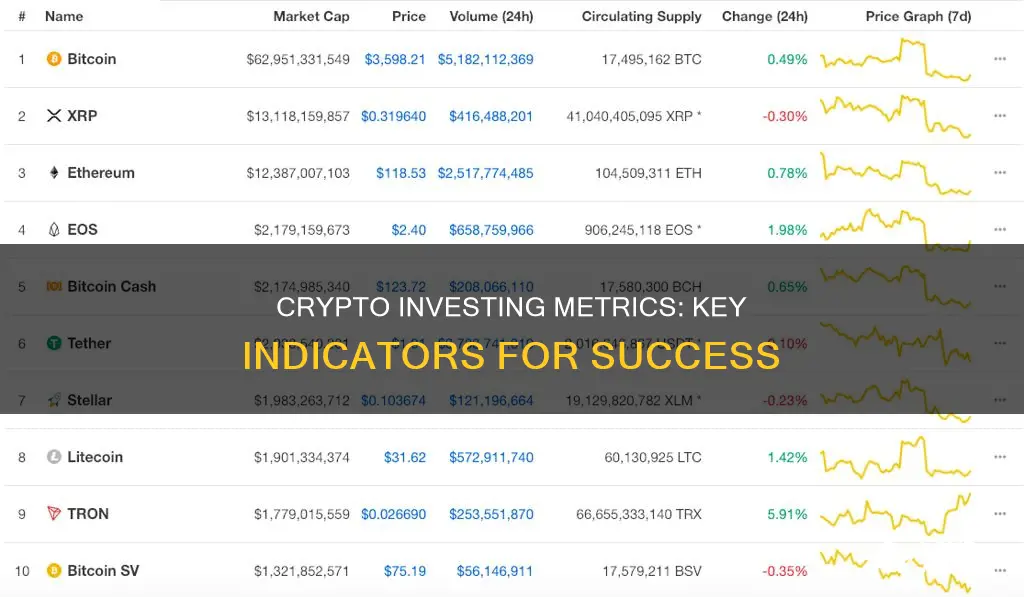
Crypto metrics are essential for investors to understand the trustworthiness and behaviour of cryptocurrencies. They are a compass guiding investors through the volatile crypto market, helping them interpret the behaviour and trustworthiness of various cryptocurrencies, and making the decision-making process more informed and efficient. Some of the most important metrics for crypto investing include market capitalisation, funding rates, 24-hour volume, open interest, exchange flows, and the Fear and Greed Index.

Market Capitalisation
Market cap is an important indicator of the value, size, and dominance of a cryptocurrency. It provides information on how much capital has been invested in a particular currency, allowing investors to evaluate its popularity and success. By analysing market capitalisation, investors can identify potential opportunities and risks to develop a sound investment strategy.
The market cap of a cryptocurrency reflects its popularity over the long term. A high market cap indicates a dominant position in the market, and these large-cap cryptocurrencies are generally considered lower-risk investments. They tend to be less volatile and have more liquidity to withstand market volatility. Examples of large-cap cryptocurrencies include Bitcoin (BTC) and Ethereum (ETH).
On the other hand, small-cap cryptocurrencies have a market cap of less than $1 billion and are deemed riskier investments. They are highly susceptible to market volatility and may not have the liquidity to withstand sudden or high-volume market movements. However, they often have more room to grow and present short-term growth potential.
It is important to note that market capitalisation should not be the sole factor in investment decisions. Other factors such as the underlying technology, development team, market acceptance, and potential for future growth should also be considered. Additionally, investors should be cautious of misleading information in market cap calculations, especially regarding the circulating supply of coins.
Invest in Crypto Privately: Avoid KYC Requirements
You may want to see also

Funding Rates
Understanding Funding Rates
Calculating Funding Rates
The calculation of funding rates involves several steps. First, identify the price discrepancy between the futures and spot market prices of the asset. Next, calculate the rate of discrepancy as a percentage of the market price. Then, determine the funding rate as a fraction of the discrepancy rate. Finally, apply this funding rate as a fee to the trader's account. For instance, if the market price of Bitcoin is $60,000 and the perpetual futures contract price is $60,300, the funding rate calculation ensures that those expecting a price increase compensate those betting on a decrease.
Impact on Trading Strategies
Factors Influencing Funding Rates
Several factors influence funding rates in crypto trading:
- Market Demand and Supply: The balance between long (buying) and short (selling) positions significantly affects funding rates. More long positions tend to increase funding rates, while an abundance of short positions can drive rates down.
- Funding Rate Volatility: High volatility in crypto prices can lead to frequent and larger adjustments in funding rates as the risks associated with holding positions increase.
- Leverage: The use of leverage amplifies gains and losses, and high leverage across the market can result in higher funding rates as traders are willing to pay more to maintain their positions.
- External Market Conditions: Events outside the crypto market, such as new regulations or economic sanctions, can impact trader sentiment and activity, leading to adjustments in funding rates.
In conclusion, funding rates are a vital tool for crypto investors, providing insights into market sentiment and helping make informed trading decisions. By understanding funding rates and their dynamics, traders can enhance profitability and navigate the complex landscape of perpetual contracts in cryptocurrency markets.
Request Coin: Worth Investing or Just Another Crypto?
You may want to see also

24h Volume
When investing in cryptocurrency, one of the most important metrics to consider is the 24-hour volume. This metric shows how much cryptocurrency has been traded in the last 24 hours and is usually displayed at the top of exchange platforms.
Volume is a crucial indicator for traders as it helps determine the future profitability of a cryptocurrency. It indicates the normal rate of movement of a coin and signals any deviations from this normal rate. For example, if a coin with typically low trading volume suddenly experiences high trading volume, this could indicate increased support and a potential rise in value. By analysing a coin's volume over short and long periods, investors can predict its future movements.
Cryptocurrency exchanges make money by charging fees on cryptocurrency trades, so a higher volume of transactions is beneficial for them. Additionally, a greater volume of transactions leads to fairer cryptocurrency prices and reduces the chance of distorted pricing. It is similar to the concept of liquidity, but while volume refers to the total trades taking place, liquidity refers to the amount available for trading at a single price.
Low cryptocurrency exchange volume, on the other hand, can indicate inefficient or low trades, where sellers' asking prices do not meet buyers' bids. However, low-volume exchanges can also create arbitrage opportunities for investors. They may be able to buy cryptocurrencies at a very low price on one exchange and then sell them for a premium on another exchange.
Therefore, 24-hour volume is an essential metric for crypto investors to consider when making investment decisions and predicting the future value of a cryptocurrency.
A Beginner's Guide: Investing in Bitcoin in Kenya
You may want to see also

Open Interest
High open interest creates opportunities to buy and sell. This liquidity helps traders move into and out of positions quickly. If liquidity is low (low open interest), traders may have difficulty entering and exiting the market.
In summary, open interest is a critical tool for crypto investors as it provides valuable insights into market sentiment, liquidity, and potential price swings. It helps investors make well-informed investment decisions and identify potential trading opportunities.
DYP Coin: A Smart Investment Decision?
You may want to see also

Exchange Flows
Exchange flow is a crucial concept in the world of cryptocurrency investing, encompassing the inflow and outflow of crypto assets on exchanges. These flows provide valuable insights into market sentiment, liquidity, and potential price movements.
Exchange Inflow
Exchange inflow refers to the net quantity of cash or digital assets entering the market through cryptocurrency exchanges. This occurs when there are more sellers than buyers for a specific asset, increasing demand and driving up prices. Inflows can happen due to trading activity, transfers from external wallets, or deposits from traditional financial institutions or fiat money. High inflows can indicate increased trading activity or interest in specific cryptocurrencies, potentially impacting market trends and prices.
Exchange Outflow
On the other hand, exchange outflow represents the net quantity of funds or digital assets leaving the market from cryptocurrency exchanges. This happens when there are more sellers than buyers, reducing demand and putting downward pressure on prices. Outflows occur when investors transfer their crypto holdings from exchange wallets to external or personal wallets for long-term storage, trading on other exchanges, or enhanced security. Monitoring outflows is essential for understanding investor behaviour and market dynamics, as large withdrawals may indicate selling intentions or investor fears, influencing market sentiment and liquidity.
Net Flow
The net flow of an exchange is calculated by subtracting the outflows from the inflows. A positive net flow suggests that the market is attracting capital from investors, while a negative net flow indicates capital outflows and potential loss of investment. Net flows provide insights into the general sentiment of the market and can be used to assess the attractiveness of an investment option.
Factors Influencing Exchange Flows
Several factors can influence exchange flows, including economic conditions, market sentiment, and interest rates. During favourable economic conditions, individuals may be more inclined to invest in financial markets. Positive market sentiment and outlook can also encourage investment, while a lack of trust or negative sentiment may lead to outflows. Interest rates play a role, as low-interest rates may prompt investors to seek higher returns, and high-interest rates may deter stock market investment.
Coinbase Index Fund: A Guide to Investing
You may want to see also
Frequently asked questions
Market capitalisation, or market cap, is the total value of a cryptocurrency project. It is calculated by multiplying the current coin price by its circulating supply. Market cap is important because it shows how much money people have invested in the network and allows investors to compare the market size of a cryptocurrency to other coins.
Funding rates are regular payments made by traders to keep the price of a perpetual futures contract close to the index price. A perpetual futures contract is an agreement to buy or sell an asset with no expiration date. Funding rates reflect traders' sentiments in the perpetual swaps market. Positive funding rates indicate that long-term traders are willing to pay short-term traders for funding, while negative funding rates suggest that short-term traders have the upper hand.
The 24-hour volume metric represents the total number of tokens traded within a 24-hour period. It provides insight into the crypto's liquidity and popularity, indicating the market demand for the cryptocurrency. A high trading volume typically indicates healthy interest and more active trading, resulting in more accurate and stable price valuations.
Open interest is a volume-based metric that represents the total number of open positions (both long and short) held by market participants at any given time. It is calculated by adding all open trade positions and subtracting the total number of closed trades. Open interest provides a broad indication of capital inflows and outflows in the market. As more money flows into the market, open interest increases, suggesting heightened interest and volatility.







